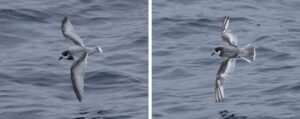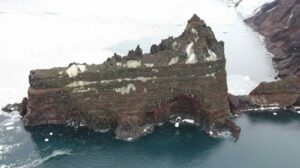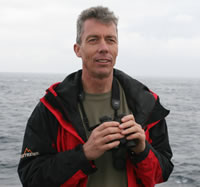By Peter Ryan, onboard scientist, expert in general ornithology, seabird-fishery interactions, evolutionary ecology, marine debris, solid waste management, biology of oceanic islands.
Leg 2, Mount Siple to Peter the First
We left the ROPOS site at 74°S, southwest of Mount Siple, early on 12 February and back-tracked through the iceberg ‘graveyard’, past Lovill Bluff and the north coast of Mount Siple, before heading east-northeast towards Peter the First. This day was pretty quiet, with only 130 birds seen in almost 200 km of transects: Snow Petrels and Adélie and Emperor Penguins were the most common bird species. Marine mammals also were sparse, with only a few Minke Whales and a couple of seals. 13 February was very different – we lost most of the sea ice and all of the penguins, but had the highest single day bird count on ACE so far – more than 2100 birds in 261 km of transects, thanks to large flocks of Blue Petrels (more than 2000 in total). Most of the larger flocks flocks were sitting on the water, with about half to two-thirds of these birds in heavy moult. We know from activity loggers that prions (and likely Blue Petrels) spend much more time sitting during their rapid moult, presumably because their flight ability is impaired. The image below shows a bird that is not only growing 6 of its 10 primaries (the main flight feathers on a bird’s ‘hand’), but also has dropped all its greater coverts (the feathers that cover the secondaries (the flight feathers on a bird’s forearm). It is just about possible that these are adults moulting immediately after breeding, but more likely they are failed breeders of immature birds. Diego Ramirez, our next island to visit, supports the world’s largest population of Blue Petrels, with between 1.1 and 1.5 million pairs.

Despite the large numbers of birds, whales were virtually absent on 13 February, with only a single Hump-backed Whale seen all day. This was in stark contrast to Valentine’s Day, when whales dominated the day thanks to three groups of Killer Whales, 33 Hump-backed Whales and a few Minke Whales. The day started with the ship deviating north from our intended track to avoid an area of sea-ice, giving us another batch of ice-associated animals (140 Crabeater Seals, a Leopard Seal, and Antarctic Petrels and Arctic Terns, but surprisingly no Snow Petrels). Once around this patch of ice, it was back to more Blue Petrels (albeit in smaller numbers) and a smattering of other open-water species.
15 February started in much the same vein as the 14th, but with even fewer birds. One group of Killer Whales was seen, and Hump-backed Whales were again common. A couple of Grey-headed Albatrosses were our first mollymawks since leaving Scott Island. Shortly before 11h00 we got our first glimpse of Peter the First, and soon thereafter we turned into some quite thick pack ice to push south towards the island. Southern Fulmars were the most common bird, but it was the impressive numbers of seals that drew most attention. We saw more than 600 Crabeater and 5 Leopard Seals in about 30 km of transects, giving a density of around 60 seals/km2. Fewer Crabeaters were seen on our exit from Peter the First (when we only traveled through about 12 km of sea-ice), possibly because many more were in the water, feeding as dusk descended (and presumably krill moved closer to the surface).
Once again no litter or kelp was seen, but feathers were abundant, especially close to Peter the First. The bird and mammal list for the 1086 km of transects from Mount Siple to Peter the First was:
| Blue Petrel | 2450 | Antarctic Petrel | 168 |
| Antarctic Fulmar | 151 | Snow Petrel | 129 |
| Cape (Pintado) Petrel | 113 | Arctic Tern | 80 |
| Adélie Penguin | 36 | Southern Giant Petrel | 36 |
| Wilson’s Storm Petrel | 25 | Emperor Penguin | 21 |
| Mottled Petrel | 20 | South Polar Skua | 10 |
| Light-mantled Albatross | 9 | Grey-headed Albatross | 2 |
| Crabeater Seal | 828 | Hump-backed Whale | 60 |
| Killer Whale | 31 | Leopard Seal | 10 |
| Antarctic Minke Whale | 9 | ?Bottlenosed Whale | 2 |
| Weddell Seal | 1 | Unidentified whales | 1 |
Our visit to Peter the First was all too brief, but we did manage a quick flight along the cliffs on the northwest corner of the island, where thousands of pairs of Southern Fulmars breed. The images obtained will provide a baseline against which possible future population changes can be assessed.


